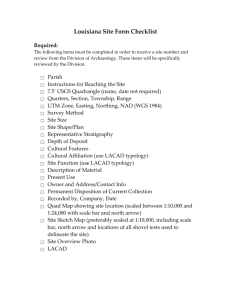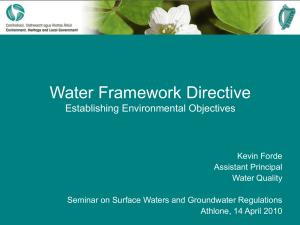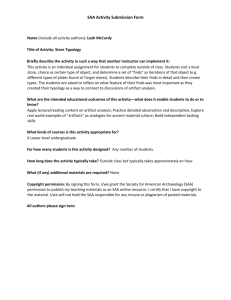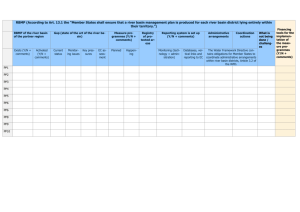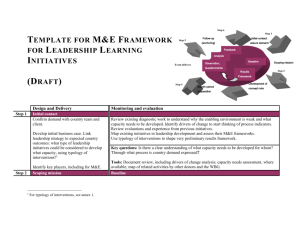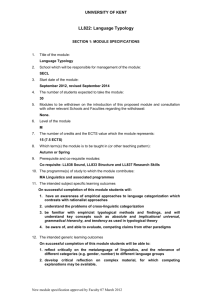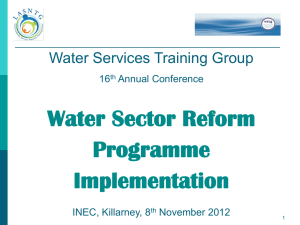1. why a typology of the water BODIES
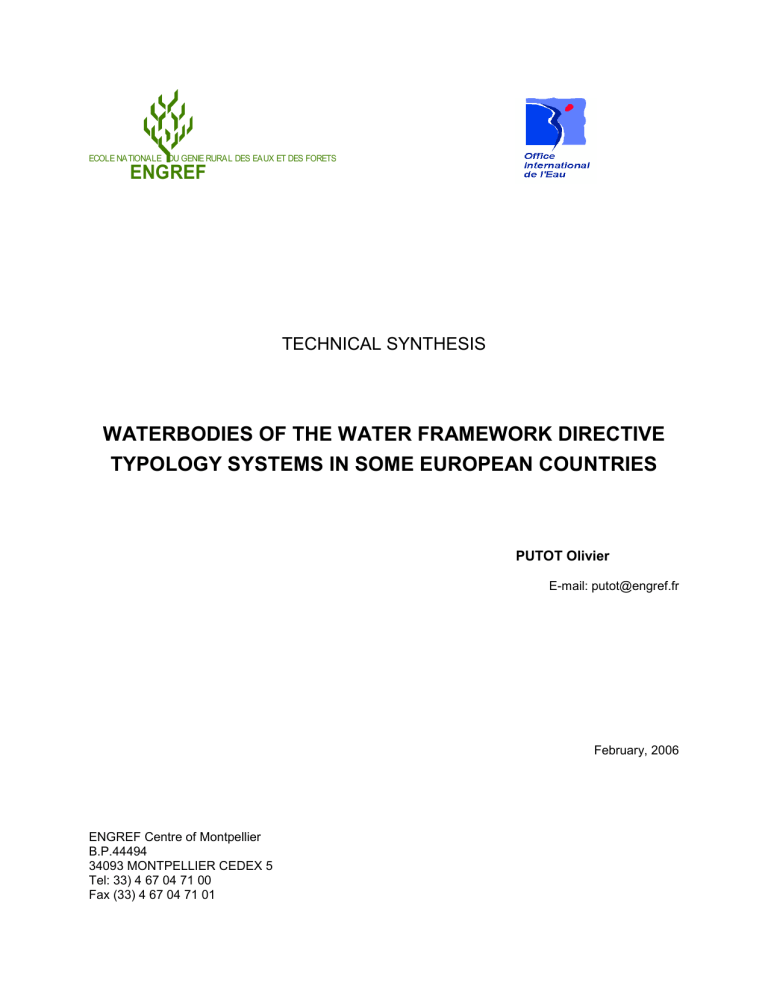
ECOLE NATIONALE DU GENIE RURAL DES EAUX ET DES FORETS
ENGREF
TECHNICAL SYNTHESIS
WATERBODIES OF THE WATER FRAMEWORK DIRECTIVE
TYPOLOGY SYSTEMS IN SOME EUROPEAN COUNTRIES
PUTOT Olivier
E-mail: putot@engref.fr
February, 2006
ENGREF Centre of Montpellier
B.P.44494
34093 MONTPELLIER CEDEX 5
Tel: 33) 4 67 04 71 00
Fax (33) 4 67 04 71 01
ABSTRACT
The European Water Framework Directive sets the objective to reach good water status for all waters by 2015. It divides waters into bodies of surface water or groundwater, which are required to be aggregated into ecological types.
The number and different types of water bodies result from the methods used by Member
States. These are related to local past ecological research, to the organization of water services, to physical characteristics and to what the actors believe the topology is needed for.
Keywords: WFD, water body, typology, good ecological status.
The Water Framework Directive (WFD, 2000) puts down the milestones of a new policy for water at an European sca le. It notably introduces the objective to reach “good water status” (ecological and chemical) for all waters by 2015, to preserve those which have a "very good status" and to reach maximum ecological potential, for artificial and heavily modified water bodies.
The chemical status to be reached is the same for all waters. On the other hand, the ecological status to be reached depends on the type of ecosystem concerned. In the name of the principle of subsidiarity, every Member State must classify its waters according to different types, guided by a theoretical framework. The object of this synthesis is to compare the approaches used by some European countries, to analyze acquired results and to discuss issues concerning typology.
1. WHY A TYPOLOGY OF THE WATER BODIES ?
1.1. CONCEPTS LINKED TO THE WFD
The river basin district is the geographical unit of management of the WFD (WFD, 2000). They were chosen by Member States in 2004. In the case of France, this unit is slightly different to traditional divisions associated with the water agencies.
The ecological status is assessed from biological and physicochemical parameters. These parameters are left to the initiative of Member States, on the basis of minimum criteria
(attachment V, WFD, 2000).
The achievement of the objectives of the WFD will be judged on the scale of the water body . It is a unit of study and assessment. The WFD defines five categories of water bodies:
continental surface waters : rivers and lakes
.
coastal waters and transitional waters
.
groundwaters
.
Types of water bodies are defined within these categories (1.2 and Figure1), and linked to the ecosystems.
The natural or altered status of a water body refers to human pressures. This status is primordial since it conditions objectives to be attained. A heavily modified water body is a water body morphologically changed by human pressures, and which cannot be restored without having negative impact on the environment or on certain activities such as navigation, drinking water or electricity. (WFD, 2000). This status will have to be justified every six years. An artificial water body is a water body which does not predate human activity. Both heavily modified and artificial water bodies have to reach maximum ecological potential - which takes into account a certain initial status, contrary to good ecological status to be reached for the natural water bodies - and a good chemical status. For groundwaters, water bodies that might not reach good status by 2015 have to be identified and a management plan has to be worked out (Normand M. and Gravier A., 2005).
1.2. THE REASONS OF A TYPOLOGY
The ecological status of a water body will be judged by a ratio between the observed biological value and reference conditions (European Commission Refcond Working Group, 2003),
(Bazerque MF., 2005). Reference conditions are the most probable natural conditions in the absence of human activity, or in the presence of activities of which effects can be neglected.
Good status corresponds to a slight difference with the reference value.
These reference conditions are different between water bodies. They depend on the environmental type to which can be attached the water body.
Typology was therefore set to have appropriate objectives, and management plans best adapted at a local level. Therefore every type has its specific reference conditions. categories physical characteristics type ecology state human activity type1 natural heavily modified rivers lakes type2 type3 etc… artificial
WATER BODY coastal transitional no risks groundwater type a type b type c
… doubts risks
Figure 1: Place of typology systems in the qualification process of a water body not to reach good water status
1.3. TYPOLOGY ON THE WAY TO GOOD ECOLOGICAL STATUS
The limits of the water bodies and their attribution in an ecological type are a part of a river basins analysis. Every Member State had to return this information for 2004.
Documents of interpretation
European working groups formed together in order to arrive at a shared interpretation of the text
(concerning the typology of the water bodies: reference conditions and inter-calibration working groups..). These groups wrote guideline documents. On a national scale, some other groups
(within MEDD in France) transmit information to competent authorities.
The scientific and local intermediaries
Competent authorities were named at the scale of the river basin districts. In France, competent authorities are DIREN and water agencies. The technical aspects of typology were examined by concerned research organisms: CEMAGREF, BRGM and IFREMER (Wasson JG, Chandesris
A, Pella A, White L, 2002), (BRGM, MEDD, 2003). In the other countries, the competent authorities are often the ministries in charge of water management.
River basin analysis
Accomplished in each river basin district for 2004, it identifies the water bodies, appoints them a type and specifies those who risk not reaching environmental targets for 2015.
Constitution of the network of reference sites
The network of reference sites aims at constituting the lists of appropriate biological parameter values, for each type of water body. Reference sites are not the whole water body, and are not necessarily completely immune from human pressures and impacts. They are often found among rivers medium to very small. For types of water bodies without reference sites, modeling and/or expert judgments are used (European Commission Refcond Working Group, 2003). The objective in France is to find 450 sites.
European network of inter calibration
The inter calibration exercise aims at comparing the approaches of the different countries, on the basis of types of water bodies shared by several Member States. Up until 2006, States are comparing sites considered representative of the « good status» and try to get similar levels of requirement (European Commission Intercalibration Working Group, on 2003).
River basin district management plans
After 6 years, these plans will be set up in 2007/2008. They involve concrete measures for the realization of the objective of "good water status" for all waters by 2015.
2. THE CHOICES OF TYPOLOGY AT THE EUROPEEN LEVEL
2.1. RECOMMENDATIONS
Surface water bodies
The WFD suggests two possible approaches for the typology of surface waters, ie A and B represented below (figure 2). The General principle is to separate the water bodies into different classes according to several criteria. The A system is very strict while the B system leaves more freedom to Member States. States are authorized to use the B system provided that it is as precise as the A system would have been (WFD, 2000), (European Commission Water Bodies
Working Group, 2003).
The A system is based on the Illies ecoregions 1 and imposes in a rigid system of factors and class boundaries, while the B system offers obligatory and optional factors, without specifying class boundaries (Figure 2).
Descriptor
Ecoregion
Altitude
Nb of categories
25
3
Catchment area
Geology
A system
4
3
Obligatory factors
Altitude
Latitude
Longitude
Geology
Size
B system
Optional factors
Distance from river source
Energy flow (function of flow and slope)
Mean water width
Mean water depth
… and 11 other possible factors
Figure 2: A and B systems factors, in the case of rivers (attachment II of the WFD, 2000)
Descriptors are recommended the same way for other surface water categories.
Groundwaters
The recommendations from the WFD leave a rather wide field of interpretations concerning identification and limits water bodies. Member States initiated a common work project leading to the writing of a guide of recommendations. It defined general principles but left the size of the water bodies to the initiative of Member States (European Commission Water Bodies Working
Group, 2003).
2.2. CHOICES MADE BY MEMBER STATES
Plebiscite of the system B
Member States predominantly decided on system B (Figure 3), A system being often judged as falling short of environmental realism or not representing the concerned territory.
8
Figure 3: Choice of system A or B
Case of rivers
7
6
5
4
3
2
Number of Member
States
United
Kingdom
Netherlands
Belgium
Portugal
Germany
France
Estonia
Norway
1
0
System A System B
1 Illies ecoregions : Bio geographical areas for aquatic insects found by Illies in: Illies J. (1978).
Limnofauna Europaea . 2 nd edition, Gustav Fischer Verlag, Stuttgart, 532 p.
Promotion of former studies
System B leaves initiative to Member States with the choice of the factors. Because of the tight deadlines of the WFD, Member States often tried to promote works undertaken before. Indeed, system B allowed this to a certain extent.
So France used “hydroécorégions 2 ”, which were developed previously by CEMAGREF. They could be linked to obligatory factors of the WFD. Same for the ground waters, water bodies 80 % developed from the first version of BDRHF (French Hydrogeological Database) of BRGM.
However it was necessary to review the limits of water bodies, since a minimal surface of 300 km ² was requested at the national level, to restrict the number of water bodies (Mardhel V.,
2005).
In Belgium, the ecoregions were revised on the basis of former studies, which had notably already served for establishing subsidies (Libert PN., 2005). The limits of the groundwater- water bodies in some German länder also lean on former studies.
Choice of the optional factors
It is interesting to consider the factors chosen by Member States (Figure 4).
Altitude
Latitude
Longitude
Géology
Size distance from river source
Energy flow (function of flow and slope)
Mean water width
Mean water depth
Mean water slope
Form and shape of main river bed
River discharge (flow) category
Valley shape
Transport of solids
Acid neutralising capacity
Mean substratum composition
Chloride
Air temperature range
Mean air temperature
Précipitations
Norway
Climate areas: 3
Ecoregions: 6 alcalinity: 3
2 turbidity/colors:2
Estonia
1
1
1
4
5
Germany yes type A ecoregion type A ecoregion yes yes yes
Portugal yes, continuous variable
1
1 degree of mineralisation: 3
4 yes, continuous variable yes, continuous variable
Belgium (Wallon region) great natural regions: 5 great natural regions: 5 great natural regions: 5 great natural regions: 5
4
3; linked with fish areas
France hydro écorégions: 22 hydro écorégions: 22 hydro écorégions: 22 hydro écorégions: 22 strahler rank: 5 fish areas upstream hydro ecorégion
Figure 4: Choices of optional factors and number of classes, case of rivers (system B)
This table demonstrates how the typology system has sometimes been adapted. The obligatory factors do not necessarily appear directly and individually, but sometimes regrouped in what could be called 'supra descriptors'. Several countries felt the necessity to modify the suggested ecoregions, considered as not discriminating enough (Norway, Walloon region, France). One could also observe that certain factors are represented only by a single class, what returns not to take them into account.
2.3. PERSPECTIVES OF EVOLUTION
Changes in typology
Chosen typology is likely to evolve with every new management plan. Several countries have already abandoned a first version (Netherlands, Walloon Region in Belgium, Portugal). In 2005
Northern Ireland has been thinking about changing over to a system B typology, for all its surface water bodies, in partnership with the Republic of Ireland (Department of the
2 Hydroécorégion : Based on geology, geomorphology, topography and climate, these ecoregions are a basis of the French typology. They were confirmed by benthic invertebrate fauna indicators (Wasson JG,
Chandresis A, Pella A, Blanc L, 2002).
Environment, 2005).
A priori and a posteriori approaches
Two main approaches can be taken (European Commission Refcond Working Group, 2002):
1. a priori approach: types are defined from knowledge of how physical drivers determine biological communities. It presupposes that expert knowledge is available,.
2.
a posteriori approach: types are distinguished by analyzing survey data from reference sites. Typology takes more into account observed biodiversity but requires the analysis of numerous data.
System A of the WFD is an example of an ‘a priori’ example; system B typologies can be defined using both approaches. In a practical way, an a posteriori approach is difficult to carry out with the little data that has already been collected up until the present, but research is under way. For instance, The Rivpacs 3 system allows defining types of rivers and lakes from the invertebrate macro populations, and has been successfully tested in England and in Sweden. Indeed, tests led in the United Kingdom by the UK River Habitat Survey Methodology show the limits of the system A typology, in order to represent ecological variability (Figure 5).
Figure 5: Comparison of two typologies. The typology on the left illustrates ecological variability well: for both A and B biological parameters, the variability of the biological parameters is smaller within types than between types. Typology on the right is not representative for ecological variability.
3 In 1997 an international conference was held at Oxford University to discuss the RIVPACS for the assessment of freshwater bodies. The scientific papers were then published in: Assessing the biological quality of fresh waters: RIVPACS and other techniques (Edited by J.F. Wright, D.W. Sutcliffe and M.T.
Furse).
3. RESULTS OBTAINED BY THE TYPOLOGY SYSTEMS
3.1. NUMBER OF TYPES
Total number
The number of types obtained is very different between the different Member States (Figure 6).
600 000
Total area
35
600 000 140
30
500 000
400 000
Total area
120
100
500 000
400 000
Number of types of lakes water bodies
25
300 000
Number of types of river water bodies
80
20
60
300 000
200 000
40
15
100 000
20
200 000
0 0
G er m an y
A us tri a
Fr an ce
U ni te d
K in gd om
P or tu ga l
Lu xe m bu rg
S ul da l (
N or w ay
)
100 000
0
Figure 6: Number of types of rivers and lakes, for some Member States
Germany Austria France Suldal
(Norway)
10
5
0
The number of types is very dependant on the typology system used, but also the results of physical diversity and the size of the Member State. The Typologies of Austria, Portugal or
France generate a lot more different types than those of United Kingdom or Germany.
Distribution of the types
Ecoregions play an important part in most of the typologies. They determine logically a geographical grouping of the water bodies of the same type. However, certain types are much more represented than others. For instance in France, 50 types of 125 represent more than 80
% of the total length of the rivers. One can also compare distribution of the types between countries having adopted the same typology (England and Northern Ireland, Figure 7) or not
(Figure 8). The analysis of these figures allows determining relative weight (in number of types) devoted to rare ecological types: it constitutes therefore a measure of the interest for rare ecological types.
100,00
Figure 7: Cumulated frequencies of different types of river water bodies in Northern Ireland and England
For the same typology results differ slightly:
The few represented water bodies are in a larger proportion in England than in
Northern Ireland. But in both cases, 20 % of types of water bodies represent 70 % of the number of water bodies (right part of Figure
7).
90,00
80,00
70,00
60,00
50,00
40,00
30,00
20,00
10,00
.
0,00
0,00
Northern Ireland
England
0,20 0,40 0,60 0,80
Cumulated frequencies of number of types
1,00
Figure 8: Cumulated frequencies of different types of river water bodies in different countries of Europe
The Walloon region typology shows a few rare types compared to the other countries.
England has the biggest proportion of underrepresented water bodies. The
German typology applied to the basin of
Danube is the one who creates the most equal distribution of types.
100
90
80
70
60
50
40
30
20
10
0
0
3.2. NUMBER OF WATER BODIES
Northern Ireland
England
Portugal
Région wallonne (Belgium)
Donau riverbasin (Germany)
0,2 0,4 0,6
Cumulated frequencies of number of types
0,8
Number of water bodies and total area
The number of water bodies obtained from different Member States compared (Figure 9).
600 000 10000 600 000
500 000
Total area
9000
8000
500 000
Total area
Nb of River water bodies
400 000
400 000
7000
6000
300 000
Number of groundwaters water bodies 300 000
200 000
5000
4000
200 000
100 000
3000
100 000
0
Germany Austria France Portugal Luxemburg
2000
1000
0
0
G er m an y
A us tri a
Fr an ce
P or tu ga l
Lu xe m bu rg
S ul da l (
N or w ay
)
U ni te d
K in gd om
Figure 9: Number of river and groundwater water bodies in different Member States
1200
1000
800
600
400
200
0
France is one of the investigated countries with the smallest number of water bodies compared to the size of the territory. For ground waters, it corresponds to a deliberate will to restrict the number of water bodies (Mardhel V., 2005). For the river water bodies, it can be a consequence of the typology or of the natural environment. Those due to typology can be calculated by the average length of the "river” water bodies.
Average length of the river water bodies
International river basin analysis is an opportunity to make comparisons between neighboring sectors that can be assumed to be ecologically similar. It is possible to calculate the average length of river water bodies and average area of groundwaters.
Figure 10: Average Characteristics of water bodies in international river basins (Water Agency Rhine -
Meuse, 2005 and DIREN Alsace, 2005)
1600
Average area of the groundw aters bodies in the superior Rhine river basin (km ²)
1400
30
25
Average length of river water bodies in the
Moselle Sarre international river basin (km)
1200
1000
20
15
800
600
10
5
400
0
200
0
1
In spite of a big variability in characteristics of the water bodies inside the German Länder, a clear tendency is the bigger size of the water bodies resulting from French typology.
Such a comparison could theoretically also be made for the lake water bodies. It would certainly correspond more to a physical reality than to a consequence of the typology system.
Choice of transitional or coastal water bodies
There is no general tendency in the numbers of transitional and coastal water bodies: some countries have more of the one, some others more of the other (Figure 11).
Figure 11: Number of transitional and coastal water
180
160
Transitional
Coastal
140 bodies
120
100
80
60
40
20
0
France Portugal England and Wales Northern Ireland
It is difficult to know if this difference is linked to typology or to the ecological reality. In France for instance, the Artois – Picardy water agency hesitated in its analysis of the river basin of
Escaut, and finally classified the downstream part of a river as a single transitional water body.
This corresponds to the desire for greater harmonization with the Dutch and Belgian methodologies, which also defined one single transitional water body for the estuary of Escaut.
In this case the choice was first of all administrative, but in other sectors the obvious choice of the transitional water bodies is morphological (salt marshes behind seawalls in England for instance).
Water bodies risking not to reach ‘good status' by 2015
For the surface water bodies, artificial and heavily modified water bodies are concerned (Figure
12).
100
90
80
Figure 12: Part of the water bodies risking not to reach good status
70
60
France
50
40
30
20
10
Northern Ireland
Portugal
0
Rivers Lakes Coastal Transitional
On the whole, lakes have the smallest chance of reaching good status. In Northern Ireland, almost every water body is concerned.
4. STAKES LINKED TO TYPOLOGY
4.1. THE INTERNATIONAL RIVER BASINS
Rapprochement of types
For the international working sectors Moselle Saar and upper Rhin, the adopted method was to keep the national approaches of the implicated countries (or even of länder for Germany). Then, competent authorities tried to find theoretically identical types on each side of the borders, which could have common reference conditions and shared status indicators. For the Moselle Saar river basin, every type is attached to a German “Wasserblick 4 ” type (Figure 13).
Figure 13: Highlighting of similar types during the rapprochement of cross-border water bodies
The numerous types of French water bodies can therefore be attached to a type of the German typology. This rapprochement is sometimes artificial, and France has officially shown doubts on at least one of the rapprochements made (Water Agency Rhine - Meuse, 2005). In the case of the upper Rhine river basin, a French type corresponds to no German type at all (DIREN Alsace,
2005). A joint program between the concerned countries took place in the area of Wadden Sea
(Netherlands, Denmark and Germany). Differences of typology between countries were highlighted here also, but insurmountable problems concerning management were not foreseen
(CWSS, 2004).
Limits of the water bodies on borders
France considers from a juridical point of view that its borders should systematically constitute a limit of the water body. So, the water bodies on the river Rhine are divided into two parts.
Nevertheless, the water bodies divided in two « are analyzed in a homogeneous manner to guarantee coherent actions and results » (DIREN Alsace, 2005). Also all groundwaters water bodies stop on countries borders. However, the cross-border character of chloride pollution in an international river basin raises questions about these limits.
4.2. PROBLEMS ENCOUNTERED
At the scale of Member States
Too many water bodies, creating administrative load, was the main problem observed. So the
Netherlands defined 300 different types in their first approach, the Walloon region 336,. Portugal produced a first number of river water bodies of 6635.
Big regional heterogeneities were at the origin of a modification of the typology system
4 Wasserblick is the federal web site on water, on which the WFD was transcripted.
(Netherlands) or not ( Bade Württemberg in Germany, figure 14). For instance, Baden
Württemberg considers its water bodies as areas which should be big enough to be homogeneous, manageable and contain the different elements of the habitat of several nesting species. This is how the siliceous streams and the small siliceous rivers were regrouped, to form functional ecosystems for fish and good management units (Federal ministry for the environment, Nature conservation and nuclear safety, 2004), (DIREN Alsace, 2005).
90
80
Figure 14: Heterogeneity between
Länder
(Germany)
Data: Federal ministry for the environment,
Nature conservation and nuclear safety, 2004.
70
60
50
40
30
Average lenght of river w ater bodies
20
10
0
Germany (average value)
Bade Würtemberg
The French institute BRGM, that is in charge of a synthesis of the characteristics of the ground water bodies, also notes some regional differences, especially concerning the methods leading to a « at risk » classification (Normand M. and Gravier A., 2005) and the taking into account of the pressures (Gravel A., 2005).
Political approach can be at the origin of observed dysfunctions. For instance the Netherlands first led a "top - down" policy, while the State did not have enough local relays. It resulted in a huge number of water bodies and in regional differences (Van Der Ploeg T., 2005).
On a local level
Several Member States regretted that many ecologically interesting elements didn’t meet the minimum standards of the WFD. They used the suppleness allowed by the WFD for, at least at a local level, lower the minimal surfaces for the lakes, and the catchment areas for rivers (France,
Great Britain, Belgium, Norway). These modifications often only apply to natural or protected entities. Water rich areas, typical of the Netherlands were also considered as water bodies.
These areas, with a lot channels, where the water is 10-20 % of the complete surface, will most likely not meet the criteria of the WFD. However water constitutes an important part of the landscape, and environmental interest is essentially linked to water. (Dutch Ministry of transport, public works and water management, 2005)
Local authorities often felt the necessity to add classes of equivalences to initial criteria, to justify the new limits of the water bodies. There are several examples. DIREN Bourgogne took into account fish population domains to regroup entities that the typology had classified into different types. This led to a better taking into account of the hydrographic network and to a reduction of the number of water bodies (DIREN Bourgogne, 2004). For cases of several types intervening over a small distance, the German land of Rhenanie-Palatinat introduced the notion of "predominant type", to avoid the accumulation of small water bodies (DIREN Alsace, 2005).
For big rivers such as the Rhone, classical typology is contrariwise not differentiated enough. To obtain limits adapted to the stakes, it is appropriate to add some criteria to find the limits of the water bodies: big confluences, big fish domains, groundwater water bodies, and human developments (Water agency RMC, 2004).
4.3. ISSUES/PROBLEMS
Many documents point out that limits and choice of types of water bodies are first of all of technical nature, and that the unit of management of the water remains the river basin. However,
it is necessary to see what is at stakes with the typology.
A typology answering various objectives
Typology must be able to answer the different objectives of the identification of the water bodies
(paragraph1.3). Concerning the description of ecosystems (and the exercise of intercalibration), a simple and transparent typology allows the most common possible repository for comparison. To be useful as a basis for defining reference conditions it may be necessary to have more complicated typologies . Different typologies may be needed for the purpose of establishing reference conditions, reporting and intercalibration. That’s why the United Kingdom issued the idea of several typologies according to objectives (European Commission refcond working group, 2002).
The size of the water bodies
Another important issue is the size of the water bodies, and notably temptation to regroup heterogeneous ecosystems in the same water body to make management easier. For the superficial water bodies, it could however create problems concerning the assessment of ‘good status': Which reference condition has to be taken into account, if for instance the water body is responsible for running waters and stagnant waters (Bazerque MF., 2003)? In France, groundwaters seem to have been perceived as a unit of management, of which the limits become less important. For instance the ground waters of Crau, in France, are located in a very sensible area, with many conflicts related to the environment. However the limits of the water bodies did not pose particular problems, because it was obvious and they reused the former limits of BDRHF. On the other hand, questions were raised several times for a special classification like the artificial water body, even if this classification is not envisaged for ground waters (Valencia G., 2005). The problems around typology are therefore mainly related to classification in natural status or not.
The status of the water bodies
For the surface water bodies, the main issues seem to be the designation of the water body as natural water or not. At a European scale, the percentage of water bodies risking to not achieve
'good status' exceeds 50 %. This is not only the consequence of the ambitious objectives of the
WFD. In certain cases, this classification corresponds to a means to avoid certain obstacles such as the lack of data or the difficulty in finding operational criteria to judge 'good status'
(WISE Newsletter, 2005). However, in Netherlands for instance, almost all of the water bodies are in this situation since the country is from a hydraulic point of view very artificial. For the ground waters, the water bodies risking to not reach 'good status' - for which a plan of action will have to be envisaged - were identified and represent more than 50 % of cases in France
(Normand M. and Gravier A., 2005). Consequences of this fact for the management of water in the European Union will be known in the years to come.
BIBLIOGRAPHY
BAZERQUE MF. (2003).
Quelle place pour les zones humides dans la directive-cadre pour une politique européenne dans le domaine de l’eau ?
Zones Humides infos n°41 – juillet 2003, 2p.
BAZERQUE MF. (2005) . Le « bon état » des eaux douces de surface : définition, calage européen, valeurs seuils provisoires. Présentation PowerPoint. Paris, MEDD, 22p.
BRGM, MEDD (2003) . Mise en œuvre de la DCE. Caractérisation initiale des masses d’eau souterraine. Guide méthodologique. Paris, MEDD, Direction de l’eau, 55p.
BRGM, MEDD (2003) . Mise en œuvre de la DCE. Identification et délimitation des masses d’eau souterraine. Guide méthodologique. Paris, MEDD, Direction de l’eau, 31p.
CWSS (2004) . Reference values in the Wadden Sea. IN :Overview Implementation WFD (Water
Framework Directive). Hamburg, TMAP WFD Workshop, 29 – 30 November 2004, 11p.
DEPARTMENT OF THE ENVIRONMENT (NORTHERN IRELAND) (2005) . WFD Summary
Report of the characterisation and impact analyses required by article 5. Belfast , Department of the Environment, 54p.
DIREN ALSACE (2005) . Secteur international du Rhin supérieur, rapport de l’état des lieux.
Metz, Préfet coordonnateur du bassin Rhin-Meuse, 114p.
DIREN BOURGOGNE (2004) . Etat des lieux Eaux de surface continentales. Présentation
PowerPoint. Dijon, DIREN Bourgogne, 36 p.
DUTCH MINISTRY OF TRANSPORT, PUBLIC WORKS AND WATER MANAGEMENT (2005) .
Delta dilemmas: implementing the WFD in the Netherlands. La Haye, Ministry of Transport,
Public Works and Water Management, 18p.
EUROPEAN COMMISSION INTERCALIBRATION WORKING GROUP (2002) . Towards a guidance on establishment of the intercalibration network and on the process of the
Intercalibration exercise. Intercalibration Working Group, Brussels, 50 p.
EUROPEAN COMMISSION REFCOND WORKING GROUP (2002). Assigning water body types: an analysis of the Refcond questionnaire results. Refcond Working Group, Brussels, 16 p.
EUROPEAN COMMISSION REFCOND WORKING GROUP (2003). Guidance on establishing reference conditions and ecological status class boundaries for inland surface waters. Refcond
Working Group, Brussels, 86 p.
EUROPEAN COMMISSION WATER BODIES WORKING GROUP (2003) . Identification of
Water bodies. Water bodies working group, Brussels, 2003, 24 p.
FEDERAL MINISTRY FOR THE ENVIRONMENT, NATURE CONSERVATION AND
NUCLEAR SAFETY (2004-1) . Water Framework Directive, Summary of river Basin District
Analysis 2004 in Germany. Berlin, Federal Ministry for the Environment, Nature Conservation and Nuclear Safety, 68p.
GRAVIER A. (2005).
BRGM Orléans. Interview in december 2005.
ISEGI (2004). Identification and delimitation of water surface bodies in the context of WFD.
Présentation powerpoint. Lisbonne, Universidade nova de Lisboa, 21p.
LANDESAMT FUR WASSERWIRTSCHAFT MUNCHEN (2005) . Umsetzung der WRRL –
Bestandsaufnahme Deutsche Donau. Munich, Bayerisches Staatsministerium fur Umwelt,
Gesundheit und Verbraucherschutz und Ministerium fur Umwelt und Verkehr Baden-
Wurttemberg, 133p .
LEBENSMINISTERIUM (2003).
IST-Bestandsanalyse : Zusammenfassung der
Ergebnisse in Österreich. Vienne, Lebensministerium, 11p.
LIBERT PN. (2005).
Ministère de la Région Wallonne, Direction Générale des Ressources
Naturelles et de l’Environnement, Observatoire des eaux de surface. Interview in november
2005.
MARDHEL V. (2005).
BRGM Orléans. Interview in november 2005. .
MEDD (2003)
. Procédure d’élaboration de l’Etat des lieux. Caractérisation du district hydrographique et registre des zones protégées. Paris, MEDD, Direction de l’eau, 2003, 60p.
MEDD (2005)
. Circulaire DCE n° 2005-11 du 29 avril 2005 relative à la typologie nationale des eaux de surface. Paris, ME DD, Direction de l’eau, 8p.
MINISTERE DE LA REGION WALLONNE (2004) . Méthodologie. Tome 3 de : Etat des lieux des sousbassins hydrographiques. Namur, Ministère de la région Wallonne, Observatoire des eaux de surface, 101p .
MINISTÉRIO DO AMBIENTE, DO ORDENAMENTO DO TERRITÓRIO E DO
DESENVOLVIMENTO REGIONAL (PORTUGAL) (2005). Relatório síntese sobre a caracterização das regiões hidrográficas prevista na directiva-quadro da água. Porto, Ministério do ambiente, do ordenamento do território e do desenvolvimento regional, 175p.
NORMAND M. ET GRAVIER A.
(2005) – Mise en œuvre de la DCE – Premières synthèses des caractéristiques principales et secondaires des masses d’eau souterraine et de l’analyse du
Risque de Non Atteinte du Bon Etat environnemental en 2015. Pist es de réflexion pour la caractérisation plus détaillée. BRGM/RP-53924-FR. Orléans, BRGM, 105p.
NVK MULTICONSULT (2004). Suldal Pilot River Basin, Norway. Provisional Article 5 Report pursuant to the Water Framework Directive. Characterisation group/NVE. Oslo , NVK, 54p.
PARLEMENT EUROPEEN ET CONSEIL DE L’UNION EUROPEENE (2000) . Directive
2000/60/CE du parlement européen et du conseil du 23 octobre 2000 établissant un cadre pour une politique communautaire dans le domaine de l'eau. Journal officiel des Commu nautés européennes, publié le 22/12/2000 , 72p.
RHIN-MEUSE WATER AGENCY (2005) . Secteur de travail international « Moselle Sarre » Etat des lieux ». Metz, Commissions internationales pour la protection de la Moselle et de la Sarre,
174p.
RHONE MEDITERRANEE CORSE WATER AGENCY (2004) . Etat des lieux du district Rhône et côtiers méditerranéens. Lyon, AE RMC, 274p + appendices.
SEINE NORMANDIE WATER AGENNCY (2004) . Etat des lieux Bassin Seine et cours d’eau côtiers normands. Nanterre, Comité de bassin Seine Normandie, 172p + appendices.
UK TECHNICAL ADVISORY GROUP ON THE WFD (2003) . Guidance groundwater delineation and characterisation. Londres , UKTAG, 2003, 6p.
UK TECHNICAL ADVISORY GROUP ON THE WFD (2003) . Guidance on typology for coastal and transitional waters of the UK and Republic of Ireland. Londres, UKTAG, 12p.
UK TECHNICAL ADVISORY GROUP ON THE WFD (2003) . Guidance on typology for Rivers for Scotland, England and Wales. Londres , UKTAG, 5p.
UK TECHNICAL ADVISORY GROUP ON THE WFD (2004) . Guidance on typology for lakes for the UK (draft). Londres , UKTAG, 7p.
VALENCIA G. (2005). DIREN Provence- Alpes- Côte d’Azur. Interview in november 2005. .
VAN DER PLOEG T. (2005).
TU Delft. Interview in november 2005. .
WASSON JG, CHANDESRIS A, PELLA A, BLANC L. (2002). Les hydro-
écorégions de France métropolitaine. Approche régionale de la typologie des eaux courantes et éléments pour la définition des peuplements de référence d’invertébrés. Lyon, CEMAGREF, 174p.
WISE (2005).
The bulletin of the Water Information Systems for Europe. Wise Newsletter, Vol.
1 – n°1 June 2005, 8p. Available on the web: http://europa.eu.int/comm/environment/water/pdf/wise_june_2005.pdf
(consulted on december
15th 2005).
GLOSSARY
BRGM : Office of Geological and Mining Researches
CEMAGREF : Research Institute for the Engineering of Agriculture and Environment
WFD : Water Framework Directive
DIREN : Regional Direction of Environment
IFREMER : French Institute for Research and Exploitation of the Sea
MEDD : Ministry of Environment and Sustainable Development
